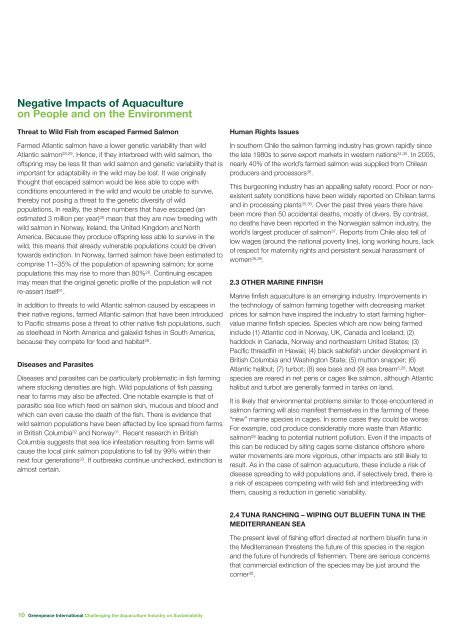Challenging the Aquaculture Industry on Sustainability-Greenpeace ...
Challenging the Aquaculture Industry on Sustainability-Greenpeace ...
Challenging the Aquaculture Industry on Sustainability-Greenpeace ...
Create successful ePaper yourself
Turn your PDF publications into a flip-book with our unique Google optimized e-Paper software.
Negative Impacts of <str<strong>on</strong>g>Aquaculture</str<strong>on</strong>g><br />
<strong>on</strong> People and <strong>on</strong> <str<strong>on</strong>g>the</str<strong>on</strong>g> Envir<strong>on</strong>ment<br />
Threat to Wild Fish from escaped Farmed Salm<strong>on</strong><br />
Farmed Atlantic salm<strong>on</strong> have a lower genetic variability than wild<br />
Atlantic salm<strong>on</strong> 28,29 . Hence, if <str<strong>on</strong>g>the</str<strong>on</strong>g>y interbreed with wild salm<strong>on</strong>, <str<strong>on</strong>g>the</str<strong>on</strong>g><br />
offspring may be less fit than wild salm<strong>on</strong> and genetic variability that is<br />
important for adaptability in <str<strong>on</strong>g>the</str<strong>on</strong>g> wild may be lost. It was originally<br />
thought that escaped salm<strong>on</strong> would be less able to cope with<br />
c<strong>on</strong>diti<strong>on</strong>s encountered in <str<strong>on</strong>g>the</str<strong>on</strong>g> wild and would be unable to survive,<br />
<str<strong>on</strong>g>the</str<strong>on</strong>g>reby not posing a threat to <str<strong>on</strong>g>the</str<strong>on</strong>g> genetic diversity of wild<br />
populati<strong>on</strong>s. In reality, <str<strong>on</strong>g>the</str<strong>on</strong>g> sheer numbers that have escaped (an<br />
estimated 3 milli<strong>on</strong> per year) 30 mean that <str<strong>on</strong>g>the</str<strong>on</strong>g>y are now breeding with<br />
wild salm<strong>on</strong> in Norway, Ireland, <str<strong>on</strong>g>the</str<strong>on</strong>g> United Kingdom and North<br />
America. Because <str<strong>on</strong>g>the</str<strong>on</strong>g>y produce offspring less able to survive in <str<strong>on</strong>g>the</str<strong>on</strong>g><br />
wild, this means that already vulnerable populati<strong>on</strong>s could be driven<br />
towards extincti<strong>on</strong>. In Norway, farmed salm<strong>on</strong> have been estimated to<br />
comprise 11–35% of <str<strong>on</strong>g>the</str<strong>on</strong>g> populati<strong>on</strong> of spawning salm<strong>on</strong>; for some<br />
populati<strong>on</strong>s this may rise to more than 80% 28 . C<strong>on</strong>tinuing escapes<br />
may mean that <str<strong>on</strong>g>the</str<strong>on</strong>g> original genetic profile of <str<strong>on</strong>g>the</str<strong>on</strong>g> populati<strong>on</strong> will not<br />
re-assert itself 31 .<br />
In additi<strong>on</strong> to threats to wild Atlantic salm<strong>on</strong> caused by escapees in<br />
<str<strong>on</strong>g>the</str<strong>on</strong>g>ir native regi<strong>on</strong>s, farmed Atlantic salm<strong>on</strong> that have been introduced<br />
to Pacific streams pose a threat to o<str<strong>on</strong>g>the</str<strong>on</strong>g>r native fish populati<strong>on</strong>s, such<br />
as steelhead in North America and galaxiid fishes in South America,<br />
because <str<strong>on</strong>g>the</str<strong>on</strong>g>y compete for food and habitat 28 .<br />
Diseases and Parasites<br />
Diseases and parasites can be particularly problematic in fish farming<br />
where stocking densities are high. Wild populati<strong>on</strong>s of fish passing<br />
near to farms may also be affected. One notable example is that of<br />
parasitic sea lice which feed <strong>on</strong> salm<strong>on</strong> skin, mucous and blood and<br />
which can even cause <str<strong>on</strong>g>the</str<strong>on</strong>g> death of <str<strong>on</strong>g>the</str<strong>on</strong>g> fish. There is evidence that<br />
wild salm<strong>on</strong> populati<strong>on</strong>s have been affected by lice spread from farms<br />
in British Columbia 32 and Norway 31 . Recent research in British<br />
Columbia suggests that sea lice infestati<strong>on</strong> resulting from farms will<br />
cause <str<strong>on</strong>g>the</str<strong>on</strong>g> local pink salm<strong>on</strong> populati<strong>on</strong>s to fall by 99% within <str<strong>on</strong>g>the</str<strong>on</strong>g>ir<br />
next four generati<strong>on</strong>s 33 . If outbreaks c<strong>on</strong>tinue unchecked, extincti<strong>on</strong> is<br />
almost certain.<br />
Human Rights Issues<br />
In sou<str<strong>on</strong>g>the</str<strong>on</strong>g>rn Chile <str<strong>on</strong>g>the</str<strong>on</strong>g> salm<strong>on</strong> farming industry has grown rapidly since<br />
<str<strong>on</strong>g>the</str<strong>on</strong>g> late 1980s to serve export markets in western nati<strong>on</strong>s 34,35 . In 2005,<br />
nearly 40% of <str<strong>on</strong>g>the</str<strong>on</strong>g> world’s farmed salm<strong>on</strong> was supplied from Chilean<br />
producers and processors 36 .<br />
This burge<strong>on</strong>ing industry has an appalling safety record. Poor or n<strong>on</strong>existent<br />
safety c<strong>on</strong>diti<strong>on</strong>s have been widely reported <strong>on</strong> Chilean farms<br />
and in processing plants 35,36 . Over <str<strong>on</strong>g>the</str<strong>on</strong>g> past three years <str<strong>on</strong>g>the</str<strong>on</strong>g>re have<br />
been more than 50 accidental deaths, mostly of divers. By c<strong>on</strong>trast,<br />
no deaths have been reported in <str<strong>on</strong>g>the</str<strong>on</strong>g> Norwegian salm<strong>on</strong> industry, <str<strong>on</strong>g>the</str<strong>on</strong>g><br />
world’s largest producer of salm<strong>on</strong> 37 . Reports from Chile also tell of<br />
low wages (around <str<strong>on</strong>g>the</str<strong>on</strong>g> nati<strong>on</strong>al poverty line), l<strong>on</strong>g working hours, lack<br />
of respect for maternity rights and persistent sexual harassment of<br />
women 35,36 .<br />
2.3 OTHER MARINE FINFISH<br />
Marine finfish aquaculture is an emerging industry. Improvements in<br />
<str<strong>on</strong>g>the</str<strong>on</strong>g> technology of salm<strong>on</strong> farming toge<str<strong>on</strong>g>the</str<strong>on</strong>g>r with decreasing market<br />
prices for salm<strong>on</strong> have inspired <str<strong>on</strong>g>the</str<strong>on</strong>g> industry to start farming highervalue<br />
marine finfish species. Species which are now being farmed<br />
include (1) Atlantic cod in Norway, UK, Canada and Iceland; (2)<br />
haddock in Canada, Norway and nor<str<strong>on</strong>g>the</str<strong>on</strong>g>astern United States; (3)<br />
Pacific threadfin in Hawaii; (4) black sablefish under development in<br />
British Columbia and Washingt<strong>on</strong> State; (5) mutt<strong>on</strong> snapper; (6)<br />
Atlantic halibut; (7) turbot; (8) sea bass and (9) sea bream 5,28 . Most<br />
species are reared in net pens or cages like salm<strong>on</strong>, although Atlantic<br />
halibut and turbot are generally farmed in tanks <strong>on</strong> land.<br />
It is likely that envir<strong>on</strong>mental problems similar to those encountered in<br />
salm<strong>on</strong> farming will also manifest <str<strong>on</strong>g>the</str<strong>on</strong>g>mselves in <str<strong>on</strong>g>the</str<strong>on</strong>g> farming of <str<strong>on</strong>g>the</str<strong>on</strong>g>se<br />
“new” marine species in cages. In some cases <str<strong>on</strong>g>the</str<strong>on</strong>g>y could be worse.<br />
For example, cod produce c<strong>on</strong>siderably more waste than Atlantic<br />
salm<strong>on</strong> 28 leading to potential nutrient polluti<strong>on</strong>. Even if <str<strong>on</strong>g>the</str<strong>on</strong>g> impacts of<br />
this can be reduced by siting cages some distance offshore where<br />
water movements are more vigorous, o<str<strong>on</strong>g>the</str<strong>on</strong>g>r impacts are still likely to<br />
result. As in <str<strong>on</strong>g>the</str<strong>on</strong>g> case of salm<strong>on</strong> aquaculture, <str<strong>on</strong>g>the</str<strong>on</strong>g>se include a risk of<br />
disease spreading to wild populati<strong>on</strong>s and, if selectively bred, <str<strong>on</strong>g>the</str<strong>on</strong>g>re is<br />
a risk of escapees competing with wild fish and interbreeding with<br />
<str<strong>on</strong>g>the</str<strong>on</strong>g>m, causing a reducti<strong>on</strong> in genetic variability.<br />
2.4 TUNA RANCHING – WIPING OUT BLUEFIN TUNA IN THE<br />
MEDITERRANEAN SEA<br />
The present level of fishing effort directed at nor<str<strong>on</strong>g>the</str<strong>on</strong>g>rn bluefin tuna in<br />
<str<strong>on</strong>g>the</str<strong>on</strong>g> Mediterranean threatens <str<strong>on</strong>g>the</str<strong>on</strong>g> future of this species in <str<strong>on</strong>g>the</str<strong>on</strong>g> regi<strong>on</strong><br />
and <str<strong>on</strong>g>the</str<strong>on</strong>g> future of hundreds of fishermen. There are serious c<strong>on</strong>cerns<br />
that commercial extincti<strong>on</strong> of <str<strong>on</strong>g>the</str<strong>on</strong>g> species may be just around <str<strong>on</strong>g>the</str<strong>on</strong>g><br />
corner 38 .<br />
10 <strong>Greenpeace</strong> Internati<strong>on</strong>al <str<strong>on</strong>g>Challenging</str<strong>on</strong>g> <str<strong>on</strong>g>the</str<strong>on</strong>g> <str<strong>on</strong>g>Aquaculture</str<strong>on</strong>g> <str<strong>on</strong>g>Industry</str<strong>on</strong>g> <strong>on</strong> <strong>Sustainability</strong>












